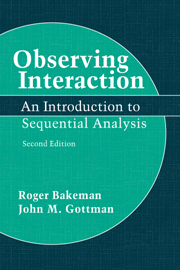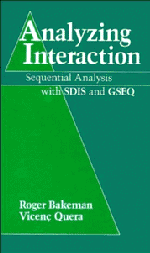Observing Interaction
Mothers and infants exchanging gleeful vocalizations, married couples discussing their problems, children playing, birds courting and monkeys fighting have this in common: their interactions with others unfold over time. Almost anyone who is interested can observe and describe such phenomena. But usually scientists demand more. They want observations that are replicable and amenable to scientific analysis, while still faithful to the dynamics of the phenomena studied. This book provides a straightforward introduction to scientific methods for observing social behavior. Because of the importance of time in the dynamics of social interaction, sequential approaches to analyzing and understanding social behavior are emphasized. An advanced knowledge of statistical analysis is not required. Instead, the authors present fundamental concepts and offer practical advice.
- Clarifies and extends material from the first edition, second edition includes expanded section on electronics and more detailed sections on sequential analysis
- Written in clear, straightforward language
- Highly accessible, fundamental concepts can be understood without statistical background
- First edition very well reviewed, praising its comprehensiveness and accessibility
Reviews & endorsements
'The book is an excellent primer for the novice and a good methods reminder for the experienced. Its major point, that sequential observation has been ignored, is a good one. It is written in a clear, readable, self-contained style with the exception of the last two chapters which require the use of additional resources listed in the bibliography. It contains very useful tables and figures, examples, and repeated summaries of major points made in each chapter and chapter section.' American Journal of Primatology
Product details
No date availablePaperback
9780521574273
224 pages
228 × 153 × 15 mm
0.315kg
30 b/w illus. 13 tables
Table of Contents
- Preface
- 1. Introduction
- 2. Developing a coding scheme
- 3. Recording behavioral sequences
- 4. Assessing observer agreement
- 5. Representing observational data
- 6. Analyzing sequential data: first steps
- 7. Analyzing event sequences
- 8. Issues in sequential analysis
- 9. Analyzing time sequences
- 10. Analyzing cross-classified events
- 11. Epilogue
- Appendix
- References
- Index.








